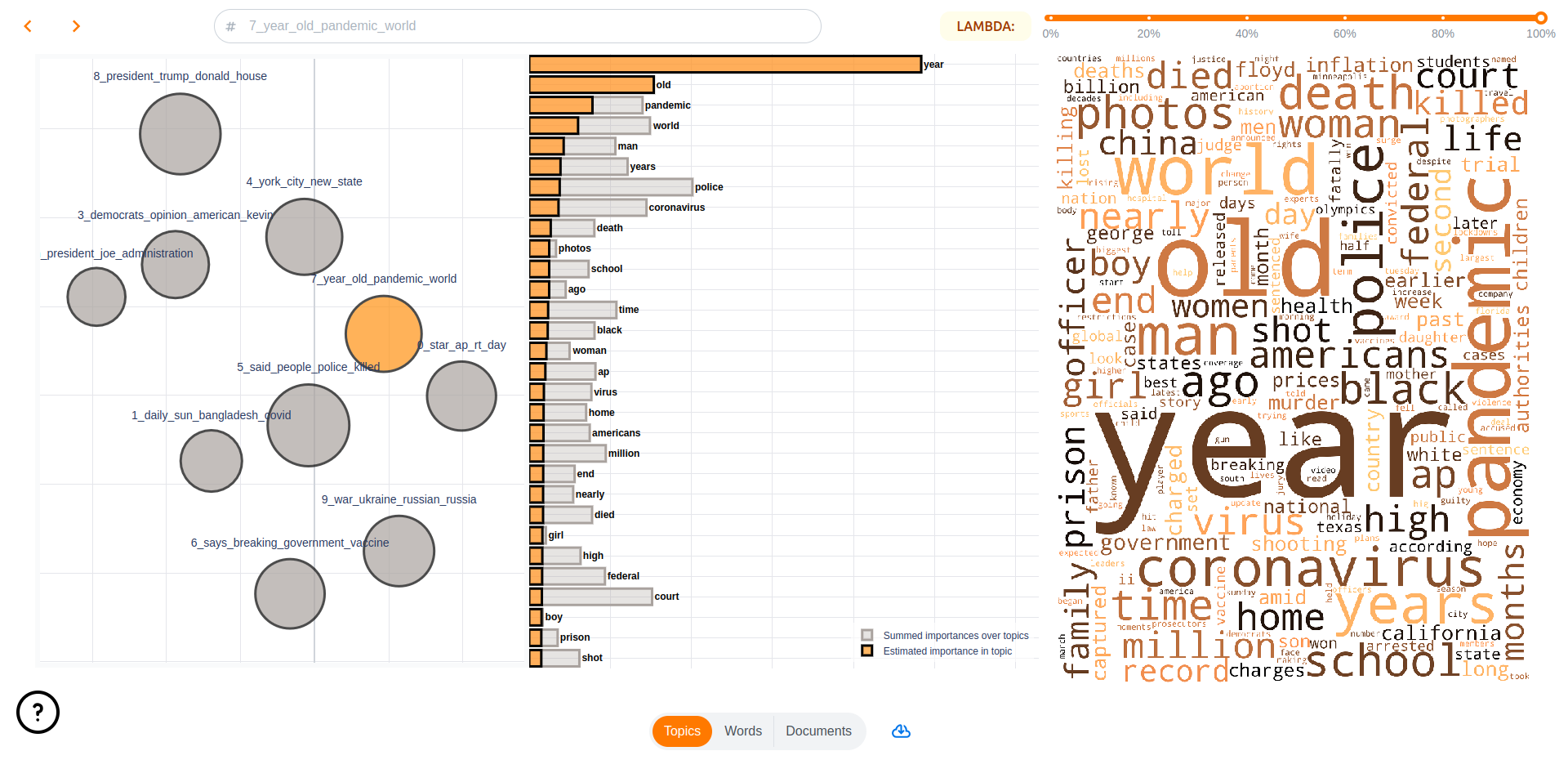Topic modeling is your turf too.
Contextual topic models with representations from transformers.
Features
- Implementations of transformer-based topic models:
- Semantic Signal Separation - S³ 🧭
- KeyNMF 🔑
- GMM :gem:
- Clustering Topic Models: BERTopic and Top2Vec
- Autoencoding Topic Models: CombinedTM and ZeroShotTM
- FASTopic
- Dynamic, Online and Hierarchical Topic Modeling
- Streamlined scikit-learn compatible API 🛠️
- Easy topic interpretation 🔍
- Automated topic naming with LLMs
- Visualization with topicwizard 🖌️
This package is still work in progress and scientific papers on some of the novel methods are currently undergoing peer-review. If you use this package and you encounter any problem, let us know by opening relevant issues.
New in version 0.10.0
You can interactively explore clusters using datamapplot directly in Turftopic!
You will first have to install datamapplot for this to work.
from turftopic import ClusteringTopicModel
from turftopic.namers import OpenAITopicNamer
model = ClusteringTopicModel(feature_importance="centroid")
model.fit(corpus)
namer = OpenAITopicNamer("gpt-4o-mini")
model.rename_topics(namer)
fig = model.plot_clusters_datamapplot()
fig.save("clusters_visualization.html")
figIf you are not running Turftopic from a Jupyter notebook, make sure to call
fig.show(). This will open up a new browser tab with the interactive figure.

New in version 0.9.0
Dynamic S³ 🧭
You can now use Semantic Signal Separation in a dynamic fashion. This allows you to investigate how semantic axes fluctuate over time, and how their content changes.
from turftopic import SemanticSignalSeparation
model = SemanticSignalSeparation(10).fit_dynamic(corpus, timestamps=ts, bins=10)
model.plot_topics_over_time()Basics (Documentation)
Installation
Turftopic can be installed from PyPI.
pip install turftopicIf you intend to use CTMs, make sure to install the package with Pyro as an optional dependency.
pip install turftopic[pyro-ppl]Fitting a Model
Turftopic's models follow the scikit-learn API conventions, and as such they are quite easy to use if you are familiar with scikit-learn workflows.
Here's an example of how you use KeyNMF, one of our models on the 20Newsgroups dataset from scikit-learn.
from sklearn.datasets import fetch_20newsgroups
newsgroups = fetch_20newsgroups(
subset="all",
remove=("headers", "footers", "quotes"),
)
corpus = newsgroups.dataTurftopic also comes with interpretation tools that make it easy to display and understand your results.
from turftopic import KeyNMF
model = KeyNMF(20).fit(corpus)Interpreting Models
Turftopic comes with a number of pretty printing utilities for interpreting the models.
To see the highest the most important words for each topic, use the print_topics() method.
model.print_topics()# Print highest ranking documents for topic 0
model.print_representative_documents(0, corpus, document_topic_matrix)model.print_topic_distribution(
"I think guns should definitely banned from all public institutions, such as schools."
)Automated Topic Naming
Turftopic now allows you to automatically assign human readable names to topics using LLMs or n-gram retrieval!
from turftopic import KeyNMF
from turftopic.namers import OpenAITopicNamer
model = KeyNMF(10).fit(corpus)
namer = OpenAITopicNamer("gpt-4o-mini")
model.rename_topics(namer)
model.print_topics()| Topic ID | Topic Name | Highest Ranking |
|---|---|---|
| 0 | Operating Systems and Software | windows, dos, os, ms, microsoft, unix, nt, memory, program, apps |
| 1 | Atheism and Belief Systems | atheism, atheist, atheists, belief, religion, religious, theists, beliefs, believe, faith |
| 2 | Computer Architecture and Performance | motherboard, ram, memory, cpu, bios, isa, speed, 486, bus, performance |
| 3 | Storage Technologies | disk, drive, scsi, drives, disks, floppy, ide, dos, controller, boot |
| ... |
Visualization
Turftopic does not come with built-in visualization utilities, topicwizard, an interactive topic model visualization library, is compatible with all models from Turftopic.
pip install topic-wizardBy far the easiest way to visualize your models for interpretation is to launch the topicwizard web app.
import topicwizard
topicwizard.visualize(corpus, model=model)
Alternatively you can use the Figures API in topicwizard for individual HTML figures.
References
- Kardos, M., Kostkan, J., Vermillet, A., Nielbo, K., Enevoldsen, K., & Rocca, R. (2024, June 13). $S^3$ - Semantic Signal separation. arXiv.org. https://arxiv.org/abs/2406.09556
- Wu, X., Nguyen, T., Zhang, D. C., Wang, W. Y., & Luu, A. T. (2024). FASTopic: A Fast, Adaptive, Stable, and Transferable Topic Modeling Paradigm. ArXiv Preprint ArXiv:2405.17978.
- Grootendorst, M. (2022, March 11). BERTopic: Neural topic modeling with a class-based TF-IDF procedure. arXiv.org. https://arxiv.org/abs/2203.05794
- Angelov, D. (2020, August 19). Top2VEC: Distributed representations of topics. arXiv.org. https://arxiv.org/abs/2008.09470
- Bianchi, F., Terragni, S., & Hovy, D. (2020, April 8). Pre-training is a Hot Topic: Contextualized Document Embeddings Improve Topic Coherence. arXiv.org. https://arxiv.org/abs/2004.03974
- Bianchi, F., Terragni, S., Hovy, D., Nozza, D., & Fersini, E. (2021). Cross-lingual Contextualized Topic Models with Zero-shot Learning. In Proceedings of the 16th Conference of the European Chapter of the Association for Computational Linguistics: Main Volume (pp. 1676–1683). Association for Computational Linguistics.
- Kristensen-McLachlan, R. D., Hicke, R. M. M., Kardos, M., & Thunø, M. (2024, October 16). Context is Key(NMF): Modelling Topical Information Dynamics in Chinese Diaspora Media. arXiv.org. https://arxiv.org/abs/2410.12791